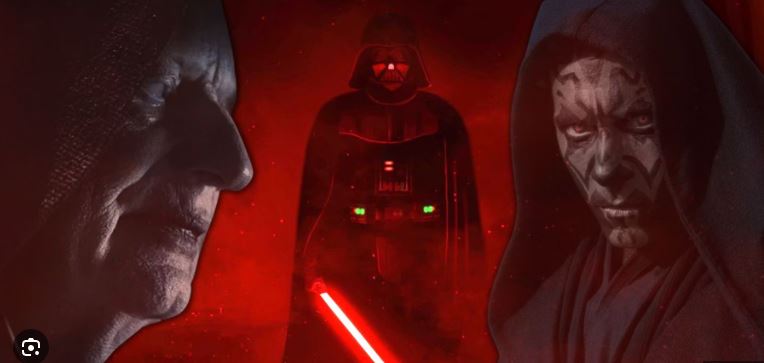Star Wars is one of the most enduring franchises in pop culture, but most of it is told through the eyes of the heroes — the Jedi. They are supposed to be the guardians of peace and justice in the galaxy far, far away, so they naturally get the spotlight more often, while their enemies, the Sith, are usually relegated just to the role of villains, without much being told about them. Now, in The Acolyte, they get their first piece of backstory in live-action, going beyond being mere antagonists to the heroes and getting some proper depth. In the old Expanded Universe (now the extra official Legends continuity), though, there is a lot to be learned about the Sith, including who they are, why they do what they do, and, most importantly, what they want. Let’s dive into the Dark Side of the Force.
The Sith Were Once Jedi in the New ‘Star Wars’ Canon
One of The Acolyte’s biggest merits is organically incorporating elements from the old Expanded Universe into the new Star Wars canon regarding the Sith. For example, Darth Sidious’ (Ian McDiarmid) legendary master, Darth Plagueis, briefly shows up in the finale of the new series after having only ever been mentioned. They are usually seen as being the opposite of the Jedi Order in every aspect. While the Jedi commune with the Light Side of the Force, the Sith draw from the Dark Side; the Jedi number in the thousands, while the Sith are only ever two; the Jedi control their emotions, whereas the Sith are ruled by theirs.
Despite all that, they were once close, even considered “brothers and sisters in the Force” by some. Millennia before the events of The Acolyte, a schism in the ancient Jedi Order happened when a single rogue Jedi started tapping into the Dark Side as a way of studying the nature of power. When discovered, he was expelled from the Order, but continued his studies and attracted followers of his own. All this happened in a period known as the Hundred-Year Darkness, and, after the formation of the Sith Order, they engaged in numerous conflicts against the Jedi. Eventually, though, they retreated to the planet Korriban (aka Moraband), and kept reemerging to fight the Jedi. This never worked, however, because their thirst for power made the Sith fight among themselves, making it easy for the Jedi to destroy them. Only one Sith survived: Darth Bane.
In Legends, there is more, though. In Korriban, the exiled rogue Jedi found a species of red-skinned sentient aliens named Sith, and that’s where the order got its name from. These aliens, often called Sith Purebloods, also exist in canon, but not much is known about them. They were strong with the Dark Side, and their customs, magic, and rituals were mixed with the knowledge the exiled Jedi had, thus leading to the Sith Order as we know it. The Purebloods were eventually extinct because of a combination of interbreeding with the exiled Jedi, internal conflicts, and the broader conflict against the Jedi.
After the Sith Were Nearly Destroyed, Darth Bane Instituted the Rule of Two

The Jedi-Sith War takes place around a thousand years before the events of Star Wars: Episode III – Revenge of the Sith. By then, the Sith are almost as numerous as the Jedi, but their infighting severely weakened their stability, making them an easy target for the Jedi. In the following millennium, the Jedi believe that the Sith have been extinct, but they are not quite right. A single Sith Lord, Darth Bane, survives the war and understands that the Sith caused their own downfall. To keep this from ever happening again, Bane creates the Rule of Two, according to which there are only ever supposed to be two Sith: a master to wield power, and an apprentice to crave it.
It’s said that Darth Bane modeled the Rule of Two after the ancient Doctrine of the Dyad. In the millennia before, the Sith attempted to create Force Dyads, a rare and powerful connection between two Force-sensitive individuals that allows them to share thoughts, feelings, and even physical abilities across vast distances, making them effectively two halves of the same whole in the Force. The Rule of Two was supposed to continue this, since another ambition of the Sith is to achieve eternal life, and a Dyad is a power as great as life itself, according to Darth Sidious in Star Wars: Episode IX – The Rise of Skywalker.
Power-hungry as they are, the Rule of Two is barely followed to the letter. Darth Bane himself, at one point, had two different apprentices: Darth Zannah was the official one, and Darth Cognus was a “backup” in case Zannah failed. None of the apprentices was aware of the other, at first, and this practice was kept by many other Sith Lords after them. For example, according to the Legends novel Darth Plagueis, the Sith Lord Darth Tenebrous also kept two apprentices who would eventually find out about each other after Tenebrous’ death, Darth Plagueis and Darth Venamis. So, the idea behind the Rule of Two isn’t necessarily to be strictly enforced but, instead, to serve as a containment mechanism so the Sith don’t expand too much, keeping in the shadows.
In The Acolyte, something similar happens. In the new canon, Plagueis doesn’t have the same story as he does in Legends, but his appearance in the finale means that there are now three Sith in the galaxy, including him, the Stranger/Qimir (Manny Jacinto), and Osha Aniseya (Amandla Stenberg). Osha is the only one whose role is known for sure as Qimir’s acolyte, but the relationship between Qimir and Plagueis is still unclear. A Sith apprentice recruiting a secret acolyte of their own before killing their master isn’t unheard of, so it might be what Qimir intends to do. Or, perhaps Plagueis and Qimir were once apprentices to the same master and are now bound for a deadly confrontation.
The Culmination of the Sith Grand Plan Is to Control the Galaxy
The Sith are mostly driven by two powerful notions: the constant hunger for power, and the fear of death. To deal with both, the Rule of Two is supposed to consolidate the Sith as a secretive order, operating in the shadows toward another creation of Darth Bane: the Sith Grand Plan, or the Sith Imperative. The main goal of the Grand Plan is to ensure control of the galaxy by the Sith, creating a new Sith Empire, and destroying the Jedi Order.
The Grand Plan involves several key components: weakening the Galactic Republic by infiltrating its institutions and eroding public trust in the Jedi Order. Over generations, Sith Lords would work in the background, slowly acting to erode the Republic’s stability and corrupt key political figures. Many Sith Lords through the centuries believed they would be the ones to finally put the Grand Plan in motion, but it was Darth Sidious who ultimately played the right cards to be elected chancellor. According to Darth Plagueis, Sidious kills his master, Plagueis, the night he is elected, parallel to the events of Star Wars: Episode I – The Phantom Menace. To ensure his continuity, he also orchestrates the Clone Wars, which resulted in the fall of the Jedi and the rise of the Galactic Empire.
Sidious also continues studies on midi-chlorian manipulation and essence transfer, dark sciences that aim to provide the Sith with eternal life. Darth Plagueis is known for having achieved the power to cheat death and keep people from dying, but most of this knowledge died with him. This, along with the establishment of a new Sith Empire, is the ultimate goal of the Grand Plan, making all other Sith traditions and directives, like the Rule of Two, obsolete. In The Acolyte, it seems that Osha may be the key for Plagueis to unlock this power, hopefully seen in an eventual Season 2.
